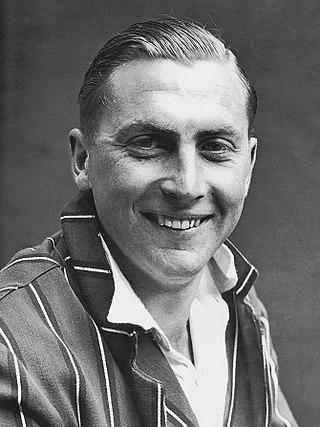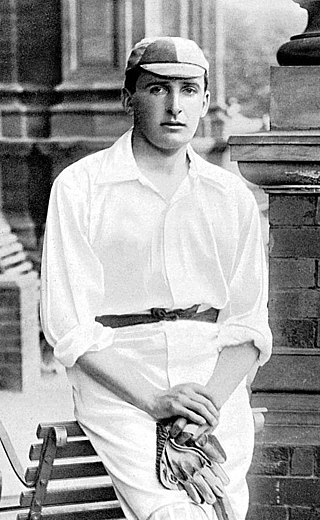
Harold Gimblett was a cricketer who played for Somerset and England. He was known for his fast scoring as an opening batsman and for the much-repeated story of his debut. In a book first published in 1982, the cricket writer and Somerset historian David Foot wrote: "Harold Gimblett is the greatest batsman Somerset has ever produced." Gimblett is a member of the Gimblett family, an Anglo-French family who arrived in Britain in the early 18th century from Metz. The family spread out over Britain, with branches located in Somerset, Scotland, and South Wales. There are variations of the spelling of the name, including Gimlet, Gimlette, and Gimblette.
Victor James Marks is an English sports journalist and former professional cricketer.

Lionel Charles Hamilton Palairet was an English amateur cricketer who played for Somerset and Oxford University. A graceful right-handed batsman, he was selected to play Test cricket for England twice in 1902. Contemporaries judged Palairet to have one of the most attractive batting styles of the period. His obituary in The Times described him as "the most beautiful batsman of all time". An unwillingness to tour during the English winter limited Palairet's Test appearances; contemporaries believed he deserved more Test caps.

Peter Michael Roebuck was an English cricketer who later became an Australian newspaper columnist and radio commentator.

Norman Stewart "Mandy" Mitchell-Innes was an amateur cricketer for Somerset, who played in one Test match for England in 1935. Between 1931 and 1949 Mitchell-Innes played 132 first-class matches, appearing 69 times for Somerset, and 43 times for Oxford University. In these matches he scored 6,944 runs, including 13 centuries and a top score of 207. He was well-regarded for the grace of his batting, but his cricket career was limited by both hay fever and his overseas work commitments.

Herbert Tremenheere Hewett was an English amateur first-class cricketer who played for Somerset, captaining the county from 1889 to 1893, as well as Oxford University and the Marylebone Cricket Club. A battling left-handed opening batsman, Hewett could post a large score in a short time against even the best bowlers. Capable of hitting the ball powerfully, he combined an excellent eye with an unorthodox style to be regarded at his peak as one of England's finest batsmen.
1947 was the 48th season of County Championship cricket in England. It is chiefly remembered for the batting performances of Denis Compton and Bill Edrich who established seasonal records that, with the subsequent reduction in the number of first-class matches, will probably never be broken. Their form was key to their team Middlesex winning the County Championship for the first time since 1921, although they were involved in a tight contest for the title with the eventual runners-up Gloucestershire, for whom Tom Goddard was the most outstanding bowler of the season. Compton and Edrich were assisted by the fact that it was the driest and sunniest English summer for a generation, ensuring plenty of good batting wickets.

William Harry Russell Andrews was an English cricketer who played for Somerset. He was a right-arm fast-medium pace bowler and useful middle-order right-handed batsman. He played 226 matches for Somerset between 1930 and 1947 and took 750 wickets at an average of 23.38 and scored 4,833 runs at an average of 15.59.

John Wemyss "Jake" Seamer was an amateur cricketer who played for Oxford University and Somerset either side of the Second World War. A bespectacled cricketer, Seamer was a right-handed batsman who played with a defensive streak to his game which was rarely seen among amateur batsmen of his time. He was described as a leg break googly bowler, but in truth he rarely bowled at all, and claimed just four first-class wickets.
George Edward Sealy Woodhouse DL had two careers: one as a cricketer for Somerset and Dorset, the second as the chairman from 1962 to his death of the family brewing company Hall and Woodhouse. As a cricketer, he was known as George Woodhouse; as a businessman, he was known as Edward Woodhouse.
Edward Stephen Massey Poyntz was an English first-class cricketer, who played for Somerset in the early twentieth century. An amateur, Poyntz was an aggressive right-handed batsman. He generally played as part of the middle order, and though his batting was not exceptional, he was highly praised for his fielding ability. He captained Somerset in the two years prior to the First World War.
Stuart Scott Rogers played first-class cricket for Somerset and captained the side from 1950 to 1952.

Edward ("Ted") Sainsbury was an English cricketer who represented, and captained, Somerset County Cricket Club in the late 19th century. During a 10-year first-class cricket career, he also represented Gloucestershire and the Marylebone Cricket Club (MCC).
John William Lee, generally known as Jack Lee, was an English cricketer who played for Somerset from 1925 to 1936, having played one match for Middlesex in 1923. He was an all-rounder, scoring six centuries and taking ten wickets in a match on two occasions by the end of his career. He was killed on active service with the British Army during the Second World War.

Vernon Tickell Hill (1871–1932) was a Welsh cricketer who made 140 first-class appearances for Somerset and Oxford University between 1891 and 1912. He first played for Somerset during their successful 1890 season. He made his top-score of 116 against Kent in 1898, sharing a seventh wicket partnership of 240 with Sammy Woods. He was an infrequent bowler, claiming 31 career first-class wickets with his right-arm fast-medium bowling, but never taking more than six wickets in a season. Hill twice toured the United States of America, first as a member of F Mitchell's XI, and then as a member of PF Warner's XI.
Somerset County Cricket Club competed in four domestic competitions during the 2009 English cricket season: the first division of the County Championship, the Friends Provident Trophy, the first division of the NatWest Pro40 League and the Twenty20 Cup. Through their performance in the Twenty20 Cup, the team qualified for the Champions League Twenty20. They enjoyed a successful season, but fell short of winning any competitions, prompting Director of Cricket Brian Rose to say "We've had enough of being cricket's nearly men."

The 1885 season was an annus horribilis for Somerset County Cricket Club. Captained by Ted Sainsbury, who had taken over from Stephen Newton, captain for the previous three seasons, they played six first-class cricket matches. Somerset's only win of the season came in their first match; all the other were lost. Two of the losses, those away against Gloucestershire and Surrey, number among the county's ten heaviest defeats. Somerset were unable to field a full team for their fourth match, which coupled with their poor results and lack of fixtures resulted in the club being stripped of its first-class status at the end of the season.
Peter Arthur Onslow Graham played first-class cricket for Somerset in six matches in 1948. He was born at Kurseong, Darjeeling, India and died on the island of Jersey.
In the final round of group matches during the 1979 Benson & Hedges Cup, a one-day cricket competition, Somerset County Cricket Club faced Worcestershire County Cricket Club at New Road, Worcester, on 24 May 1979. The result of the match would help to determine which teams progressed to the quarter-finals. If Somerset lost and Glamorgan won their match, Somerset, Worcestershire and Glamorgan would have been level on points; bowling strike rate would have then been used as a tie-breaker. The Somerset team, led by their captain, Brian Rose, realised that if they batted first and declared the innings closed after just one over, it would protect their strike rate advantage to guarantee their qualification. Somerset scored one run from their over and declared; Worcestershire took ten deliveries to score the two runs they needed to win. The match was completed in 18 minutes, and consisted of only 16 legal deliveries.
 denotes that the player appeared as a wicket-keeper for Somerset in 1948
denotes that the player appeared as a wicket-keeper for Somerset in 1948







